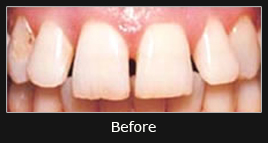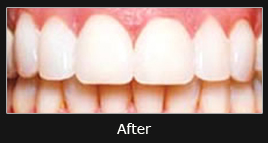
Porcelain Veneer
What are Dental Veneers?
A dental veneer is a thin layer of synthetic material (porcelain or composite) that is placed over the tooth's surface to improve the tooth's attractiveness in terms of alignment, colour or shape. A substantial aesthetic effect can be obtained with a veneer and minimal tooth preparation is required.Dental veneers have long been used to create the ultimate smile makeover.With this treatment, it's possible to transform crooked, stained, damaged or badly worn teeth into a brand new, straight, white smile, as seen on many of the Hollywood greats.
So what exactly are dental veneers?
Veneers are wafer-thin lamintates or shells of tooth-coloured material (which can be either porcelain, ceramic or composite bonding material). They are "cemented" to the front surface of teeth to improve their cosmetic appearance. Many dentists use the analogy that dental veneers are for your teeth what false fingernails are for your hands.


What treatments or problems are veneers used for?
There are a wide variety of reasons why patients opt for treatment with dental veneers:
Stained teeth- badly stained teeth can not be improved by teeth whitening or prophyflex treatments can be greatly improved by dental veneers, which function to cover any existing stains on your teeth.
Damaged teeth- teeth that have become badly worn through excessive grinding or by carbonated drinks, as well as those that have been chipped or broken, can benefit from veneers. A small chip on a tooth can quickly be repaired with composite bonding, also knows as "composite veneers". A single damaged tooth can easily be repaired with a porcelain veneer that has the same characteristics and colour as you natural teeth.
Gaps- spaces or gaps(diastimas) between your teeth can easily be closed using dental veneers, giving you a more uniform-looking smile.
Crooked teeth - Veneers are not the ideal treatment for crooked teeth, and from the point of view of preserving your natural teeth structure, orthodontics or Invisalign braces would probably a better solution. However, such treatments can take up to a year or longer. For teeth that are not severely crooked, veneers placed over their front surface will give a straight and perfectly aligned-looking smile. For this type of treatment, many people refer to veneers as "instant orthodontics", as you get a similar end result in a fraction of the time.
So which are better: composite veneers or porcelain veneers?
The most popular type of veneers is porcelain, which offers a stronger and more durable alternative to its composite counterpart. Composite veneers are also more prone to staining and do not last as long as porcelain veneers. Porcelain veneers also offer a more natural looking, translucent appearance. Composite veneers are much cheaper than porcelain veneers in general, but considering that they do not last as long and need replacing more often, they could end up costing more in the long run. Composite work is ideal for small chips, as this treatment preserves more of your natural tooth structure.
How long do dental veneers last?
Porcelain veneers will typically last between five and ten years, while composite veneers last a year or two at most. The bottom line is that your veneers will eventually need to be replaced. Although veneers are strongly cemented into place, there have been cases where they come loose and fall off. In such situations, it is important that you keep hold of your veneer and contact your dentist immediately. To make your veneers last longer, follow a good oral hygiene program and visit your dentist for check-ups on a regular basis.
Contact us right away to discuss any aspect of your dental health - we provide free dental consultations!


